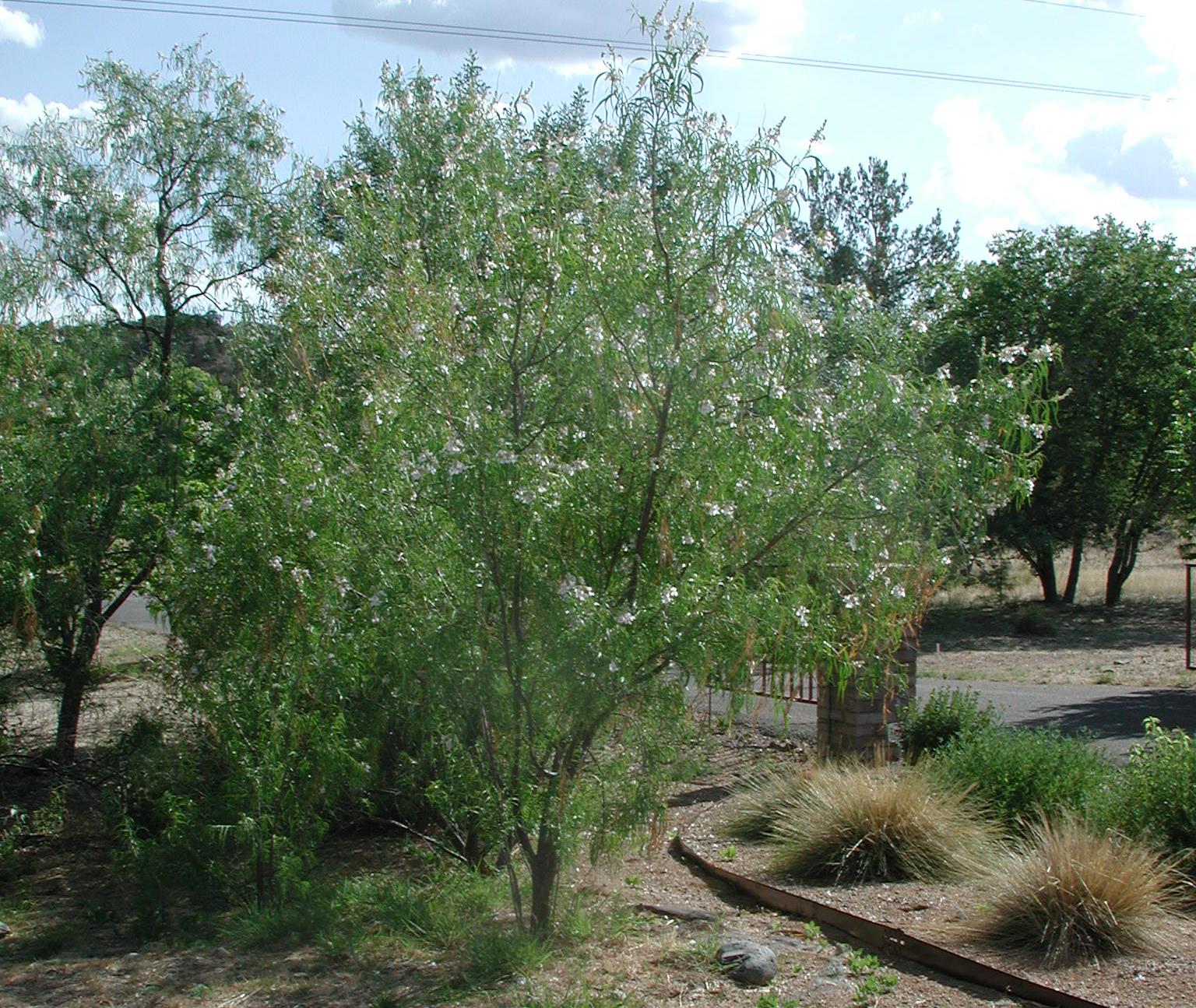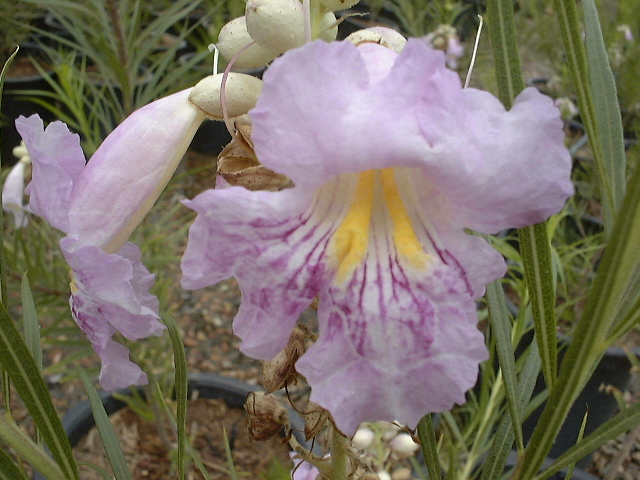 The Desert Willow Tree - June 25, 2014 Jeff Schalau, Agent, Agriculture & Natural Resources University of Arizona Cooperative Extension, Yavapai County The desert willow (Chilopsis linearis) is an excellent drought tolerant tree for north central Arizona. Desert willow is not a willow at all, but a close relative of the catalpa tree and a member of the trumpet vine family (Bignoniaceae). This deciduous, native tree/shrub can be found along dry washes and seasonal creeks in desert, chaparral, and grassland habitats between 1,500 and 5,500 foot elevations. It’s native range extends from western Texas to southern Nevada, Arizona, southern California, and northern Mexico, and as far north as Kansas. The flowers are typically nearly white in the western end of its range, to deep purple at the eastern end. Some cultivars are hardy to 0 degrees F and all require little supplemental irrigation once established. The desert willow is very graceful with an airy, open canopy. Hence, it does not make dense shade or a highly effective windbreak, but makes it a good choice in areas where security is a concern. In the wild, they can grow to 20 feet tall by 20 feet wide. With irrigation, they can get slightly larger. Some cultivars are hardy to 0 degrees F and all require little supplemental irrigation once established. It tolerates moderate pruning to develop a more orderly appearance. Desert willows are usually multi-trunked, but they can be pruned to a single trunk if desired. If training to a single trunk, you will likely have basal suckers that will need to be pruned out periodically. The narrow, curving leaves are between 3 and 5 inches long and 1/4 to 1 inch wide. They look very graceful but have a surprisingly tough, leathery texture. Desert willows are best known for their showy flowers. These appear in clusters on branch tips from late spring to late summer and can vary in color from pinkish white to deep purple. Normally, they are off-white to pale lavender with yellow spots or stripes in the throat of the trumpet-shaped blossoms. In addition, the flowers have a sweet fragrance that attracts bees, butterflies, and hummingbirds. The flowering season can be extended with supplemental irrigation during hot droughty periods (usually May and June). Long, narrow seedpods form after the flowers bloom. These persist on the tree through the winter and split open to release hundreds of fuzzy seeds. I suppose, if there is a downside to desert willow, it is this messy seasonal dropping of pods and seeds. On many cultivars and native grown trees, the seeds may germinate in a moist seedbed. Some cultivars do not produce seed pods. Being a native, the desert willow has relatively few pests or diseases. Aphids may appear on the new leaves and blossoms in the spring. These can be treated with a high pressure spray. If they are really bad, then mix 1 TBSP dish detergent with a gallon of water and spray it on. Better yet, let the natural predators and hummingbirds eat them. Cicadas can also cause twig damage. Desert willows are also reported to be somewhat resistant to Texas Root Rot: a common disease in our area. Desert willow is easy to propagate by cuttings, rooted in moist, well-drained soil. The tree may also be propagated by seeds, sown in a warm greenhouse in the spring and kept in individual pots until late in the following spring. Seedlings may then be planted in their final position in the garden. Nurseries have selected individuals from the wild, cloned them, and market these cultivars as named varieties that have showier flowers or smaller stature. Some of the newer varieties are "Barranco", "Burgundy Lace", "White Star", "Pink Star", "Lucretia Hamilton", "Warren Jones", and "Lois Adams" (a podless variety). There is also a Chitalpa (Chitalpa tashkentensis): a hybrid between the desert willow and the catalpa (Catalpa bignonoides). It was bred in Tashkent, Uzbekistan. Being an interspecific hybrid, the Chitalpa tree does not produce seed pods. I have noticed some symptoms of foliar disease on Chitalpa trees which appears to be anthracnose (a fungal leaf disease). Below, I have included photos of the whole tree and flowers. Follow the Backyard Gardener on Twitter – use the link on the BYG website. If you have other gardening questions, call the Master Gardener help line in the Camp Verde office at 928-554-8999 Ext. 3 or e-mail us at verdevalleymg@gmail.com and be sure to include your name, address and phone number. Find past Backyard Gardener columns or provide feedback at the Backyard Gardener web site: http://cals.arizona.edu/yavapai/anr/hort/byg/. Photos of Desert Willow   |